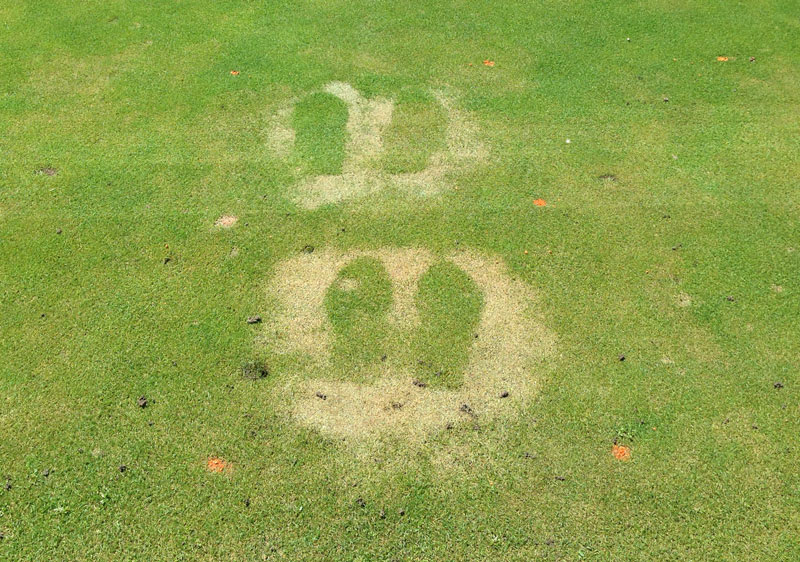
A very hands-on experiment: Palms coated in alcohol-based hand sanitizer left their mark on a bentgrass green for 10 days or longer. Photo by Ben Pease
A number of products are labeled for use on golf course turf, and superintendents take every precaution to make sure that products such as plant growth regulators, fertilizers, insecticides and herbicides are applied appropriately.
Occasionally, there may be accidental spills of products never meant to be in contact with turf — like motor oil — but a new and unexpected hazard has emerged in 2020, thanks mainly to COVID-19.
“It’s an embarrassing story,” says GCSAA Class A superintendent Tim Christians, superintendent at Makray Memorial Golf Club in Barrington, Ill. An embarrassing story involving the best of intentions — and hand sanitizer.
Makray Memorial has instituted a comprehensive program to protect employees and golfers from exposure to the COVID-19 virus. Employees practice social distancing and have their own tools, golf carts and hand sanitizer. The first day the hand sanitizer was issued, Christians quickly stuffed a bottle into his back pocket and headed out to tend to the golf course — without noticing that the bottle’s lid had popped off. After he bent down to fix a ball mark, Christians realized that a good portion of the contents of his bottle of hand sanitizer had ended up on the green.
What do you do in a case like this? If you’re Tim Christians, you call dad, because dad knows best, especially when he’s a well-known turfgrass professor: Nick Christians, Ph.D., at Iowa State University. Tim’s question: Do you think hand sanitizer will harm the grass? Dad’s answer: Probably, if it’s 60% alcohol, but let me do an experiment.
Tim soon discovered he was not alone, as golf courses around the country were supplying hand sanitizer to employees and golfers, and more than one superintendent was dealing with spills on turf. Back at Iowa State, the elder Christians turned to assistant professor Adam Thoms, Ph.D., and research assistant and graduate student Ben Pease for a hand in evaluating the hazards of hand sanitizer on greens.
The researchers used Purell Advanced Hand Sanitizer, which contains 70% ethyl alcohol, and they assumed that any hand sanitizer with more than 60% alcohol would produce similar results. On May 11, Pease applied approximately 1 ounce of hand sanitizer (about three to four pumps from the bottle) to his hands and then pressed them into the green. Three days later, chlorosis was beginning to be evident, especially in areas that had received more product. By May 22, the outline of Pease’s hands was still visible, but the turf had almost returned to normal.
For a second experiment carried out concurrently with the first, Pease again applied sanitizer to his hands and pressed them into the turf in three different areas without reapplying sanitizer. This experiment attempted to illustrate what could happen if a golfer applied hand sanitizer and then touched another object, like a golf club or a ball, and then touched the turfgrass. Each set of handprints represented a consecutively lower application of hand sanitizer. And, as Pease points out, “As concentration is reduced, turf injury lessens.”
Editor’s note: Good at guessing the cause of damaged turf? Test your savvy with some recent installments of GCM’s Photo Quiz.
The final experiment showed the effects of different rates of sanitizer on the turf. The rates were 0.25, 0.5, 0.75 and 1.0 ounce, equivalent to approximately one, two, three and four pumps from the bottle. This time, the product was applied to a metal square that was then pressed into the turf. Seven days after application, as expected, the turf treated with 0.25 ounce of product had almost completely recovered, and the turf that had received the highest rate still appeared chlorotic.
“As one would guess, a solution with a high concentration of alcohol desiccated the turf, but this seemed to just be a contact burn,” says Pease. “Only the touched parts of the plant were affected, and then only transiently as we observed recovery after 10 days or more.”

Another print-causing culprit: The chemical DEET is often deadly to turf and comes in contact with it via golfers who spray their shoes with a DEET-containing mosquito repellent while standing on turf, leaving telltale green foot impressions. Photo courtesy of Nick Christians
This isn’t the first time the team at Iowa State has investigated an unusual application on turf. In 2015, turfgrass student Zack Olinger and research associate and graduate student Dan Stray found that golfers spraying mosquito repellent containing the chemical DEET inadvertently severely damaged and killed turf. The evidence — green shoe prints on the turf — was unmistakable.
Teresa Carson is GCM’s science editor.